The Spirit of Genghis Khan
The
Stone Monoliths of Kanas, China
Article and photos by James
Michael Dorsey
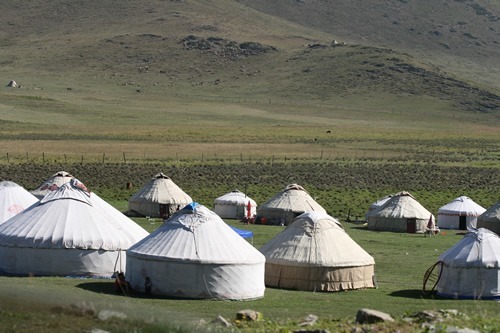
|
|
The yurts in which
the Tuvan nomads dwell in Northwestern China.
|
The high country of Northwestern China is tucked against a shark-fin line on a map that separates it from Kazakhstan, Mongolia, and Russia. Explorers and resolute travelers will discover a land soaked in myth, legend, and mystery.
Xinjiang province, also known as the Uyghur
Autonomous Region, is more Eastern European in flavor than Chinese. At the northern tip, in the Altai Mountains, Kanas is a Mongol enclave still under the spell of legendary Genghis Khan.
Tantric Buddhism, merged with animism, provides a unique background for daily life under the benign watch of a high llama. The people are mostly Tuvans,
of throat-singing fame. Tuvans are direct descendants of the Mongol cavalry that swept southwest out of these mountains a millennium and a half ago to conquer Eastern Europe. They call themselves Uryankhai (oo-rin-high), meaning "Distant forest people," and speak a Turkic dialect
mixed with Mongol.
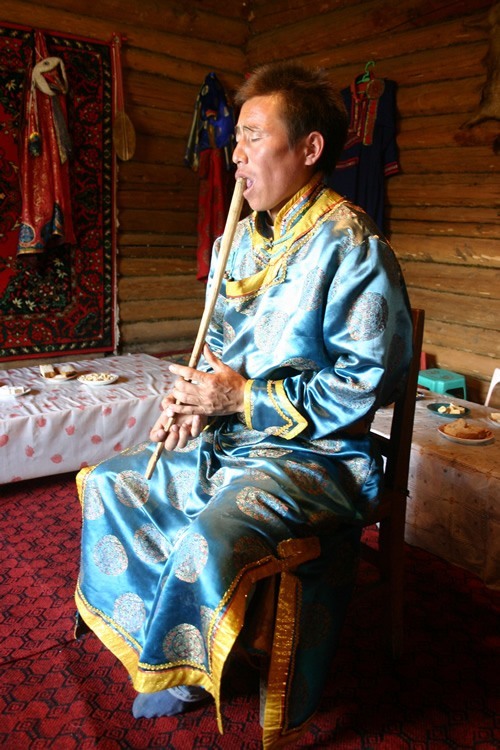
|
|
A throat-singer.
|
The Village of Hemu
The main village of Hemu is a collection of log cabins with sod roofs left behind by Russian loggers who annexed the land during the Second World War. Lizards, frogs, and snakes hang, drying in the sun, from porch eaves to be used at the appropriate time in shamanic rituals. Reindeer are kept corralled, not for meat or transport, but for their antlers. The antlers renew each season; the local people believe they contain aphrodisiacal qualities.
Every cabin has animal bone talismans by the door to ward off evil spirits. Soothsayers abound, ready to roll bones and stones to read your future. The centerpiece of every home is a portrait of the great Khan framed by a prayer scarf. All paintings are artists' interpretations, as no known image of Genghis Khan exists.
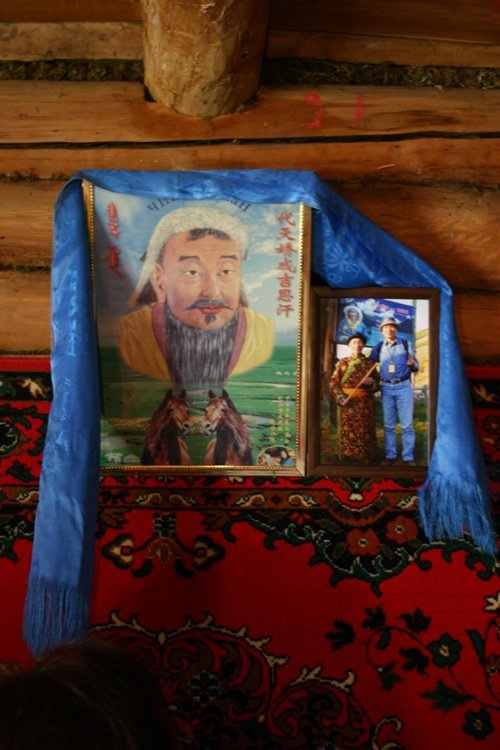
|
|
Portrait of Genghis
Khan framed by a prayer scarf.
|
In the region, people ride camels as much as they do horses. Cars are a little-known form of transportation. A common encounter in the village involves meeting a local walking around with a large hunting eagle perched with its claws atop an outstretched arm.
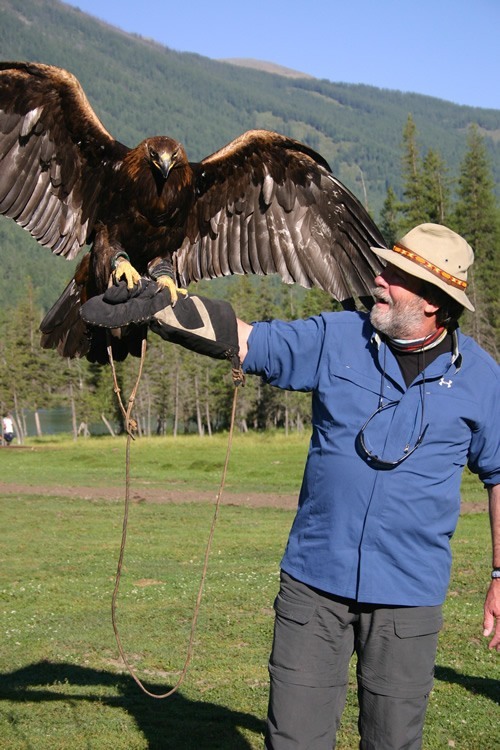
|
|
The author with
a hunting eagle perched on his arm.
|
Genghis Khan: The Man and the Legend
Genghis
Khan was born Borjigin Temujin. Military prowess aside, he was primarily a shaman steeped in Tengriism, an indigenous, animist form of ancestor worship involving totems. Today, the stone totems of Kanas are the last physical remains and verification of Temujin's mystical powers.
In his day, he was known for religious tolerance. He consulted Christian missionaries, Buddhist monks, and Muslim merchants and even sought out a Chinese Taoist monk named Qiu Chuji to interpret his teachings, all of which must have greatly influenced his thinking.
Local people will tell you that Genghis Khan's main camp was in the high valleys of Kanas, where he assembled his cavalry, inspiring them to battle through pomp and ceremony. Like all oral histories, these tales are often flavored by each storyteller and filtered through eons of history. Today, hand-carved stone monoliths, the remnants of those ceremonies, stand watch over the high country.
A Land of Stone Monoliths
Leaving Hemu behind, a drive into the highlands reveals boulder-filled valleys with felt yurts of the nomads sprouting like mushrooms after a rainstorm, each possessing hobbled camels grazing nearby and still the main form of local transport. The cabin of a local llama is easily identified by countless prayer scarves tied to the fence. A walk up most any nearby trail reveals cairns of stone, stupa-like, some with raised prayer flags, continually sending their entreaties skyward on the wind.
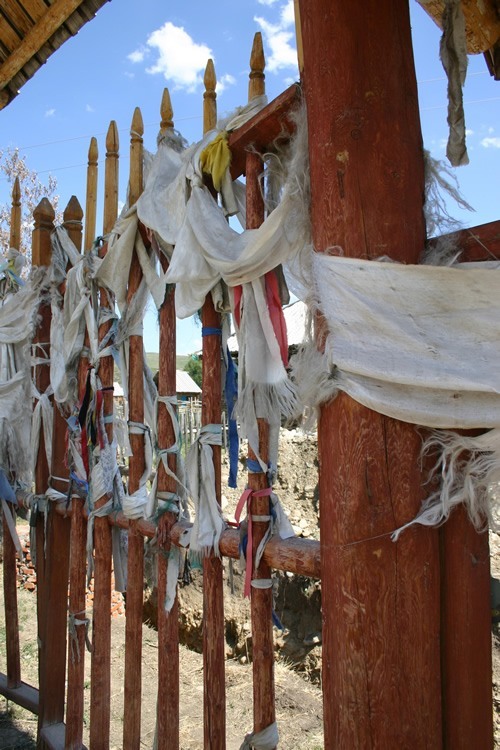
|
|
Prayer flags tied
to a fence.
|
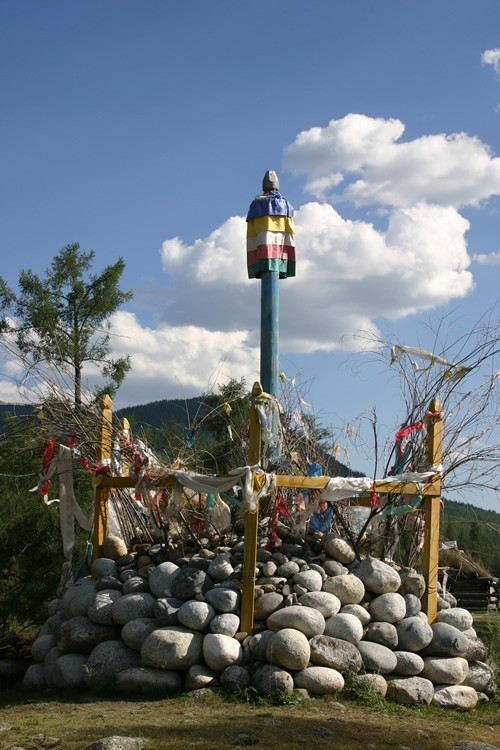
|
|
Stone cairns, the
equivalent of a shaman's shrine (altar).
|
At night, in this magical and mysterious land, stars alone illuminate the rock faces and give form to the high clouds that can fill the valleys like cotton candy. The silence can be deafening except when a throat singer begins to chant, while each yurt, in turn, adds its tonal vibrations until the mountain resonates with prayer. This is when the spirits of the monoliths roam.
From a distance, they appear in a single file, widely spaced, like wandering mendicants. Some are simple, free-standing stones, while others bear human resemblance, some have hands folded on their chest, and some have the remains of a human-like face; all are carved from local rock, most likely granite. They range in size from about three to eight feet tall. Tuvan herdsmen will tell you they speak in moans while they contract in the cold night air and expand in the morning sun.
The monoliths are rough to the touch, but that is in the very nature of the stone from which they are carved. The finished surface is remarkably smooth due to having been carved with rudimentary tools in the high mountains. However, they give no sense of being art. They are totemic, having a practical purpose rather than a decorative one. The monoliths give off an unmistakable aura of power.

|
|
Stone monolith with
arms folded.
|
But What Do the Monoliths Mean?
As with many clues left to us from the ancient past, speculation is the primary option when seeking some form of understanding. An army the size of Temujin's would have had no lack of skilled artisans and laborers. Stonemasons, capable of such carvings, are credible in producing such a juggernaut, just as they would have been invaluable artisans when besieging fortifications. A Shaman held great traditional powers. For Temujin, aka Genghis Khan, to have held shamanic powers while being a sovereign military ruler would have given him an almost deity-like status.
Ceremony has long been an effective means of whipping an army into a frenzy for battle. One can imagine the high valleys of Kanas filled with bonfires as the mighty Khan orated and cast spells. The monoliths might represent ancestors or spiritual beings. Perhaps they pay homage to warriors of particular prowess. Alternatively, they may be like Christian statues designed to focus the pilgrim on their spiritual quests and requests. The possible meanings are endless in a ritualized culture centered around symbolism, and there are as many local interpretations as there are storytellers. For now, the mysterious stones maintain their silence.
Kanas is just starting to receive the first infusion of outside trekkers. Soon, the attention will bring with it anthropologists, archeologists, and scientists of all fields to tackle the mystery of the monoliths. Little information about the mysterious monoliths exists on the web, and there are only general references from comparative religion and mythology scholars.
Like all ancient wonders left to us from past lives, symbolic works of art abound with various meanings. We may never know their true purposes, but that is ultimately not really of primary importance.
The monoliths are a physical link between a momentous time in world history and the current era. They have watched over the valley for fifteen hundred years. The mysterious stones perhaps hold stories and secrets only accessible to those who enter the spirit world.
James Michael Dorsey is
an explorer, award-winning author, photographer, and
lecturer. He has traveled extensively in 45 countries,
mostly far off the beaten path. His main pursuit
is visiting remote tribal cultures in Asia
and Africa.
|
